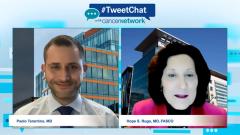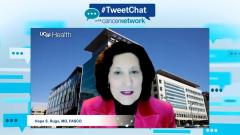
Patient Profile: A 52-Year-Old Woman with Triple-Negative Breast Cancer
Breast cancer experts Hope S. Rugo, MD, FASCO, and Paolo Tarantino, MD, present the case of a 52-year-old woman with triple-negative breast cancer and provide their initial thoughts.
Episodes in this series

Transcript:
Hope S. Rugo, MD, FASCO: Hello, and thank you for joining us for this Cancer Network® OncView program. I’m Hope Rugo, a breast medical oncologist at the University of California San Francisco’s Helen Diller Comprehensive Cancer Center, and I’m really fortunate today to be joined by my superb colleague, Dr Paolo Tarantino. Paolo, would you introduce yourself?
Paolo Tarantino, MD: Hi, everyone. It’s a pleasure to join Dr Rugo today for this Cancer Network® program. I am Paolo Tarantino, a breast oncologist and research fellow from the Dana-Farber Cancer Institute at Harvard University in Boston, Massachusetts, and today we’re going to discuss an interesting case of triple-negative breast cancer.
Hope S. Rugo, MD, FASCO: Yes, and I think the discussion that we have is really going to be fun and interesting because we have so many new treatments and new considerations. We recently shared a clinical scenario and data on treatment options for patients with triple-negative breast cancer in a Twitter chat. And today we’re going to discuss the case and go into the data in more detail. Paolo, would you begin by sharing the first part of the case with us?
Paolo Tarantino, MD: Absolutely. The case we discussed on Twitter was a 52-year-old woman with stage 2A triple-negative breast cancer that was seen in the clinic, and biomarker testing showed HER2 IHC [immunohistochemistry] 1+, that today we would call HER2-low, and we’ll discuss if there’s any implication of this FISH [fluorescence in situ hybridization] negative. And in 2019, this patient received neoadjuvant chemotherapy with dose-dense doxorubicin and cyclophosphamide, followed by paclitaxel. And then she received a lumpectomy that showed a 1 cm residual disease and negative nodes. She was treated with adjuvant capecitabine and radiation post-surgery. The patient had no pathogenic germline mutation and completed all systemic treatments in September 2020. And Dr Rugo, what are your impressions of this case? Is this a typical case, and would you treat this patient differently if she was diagnosed in 2023 instead of in 2019?
Hope S. Rugo, MD, FASCO: Or 2022. I think this a case of a patient that we see quite frequently. A situation where a patient has a tumor, maybe T2 with a positive node, without, and we give neoadjuvant therapy, and I will say that what we’ve learned since 2019 is that the first part is adding carboplatin to paclitaxel appears to really significantly improve pathologic complete response rate and now event-free survival [EFS] and overall survival. We’d already seen the PCR [polymerase chain reaction] data and the suggestion of improvement in event-free survival from data from neoadjuvant smaller trials from the German Breast Group and from the Alliance for Clinical Trials in Oncology. Then we saw the BrighTNess trial, a European/United States collaboration, which suggested an EFS benefit.
But the trial that was presented at the San Antonio Breast Cancer Symposium in December 2022, by Sudeep Gupta, MD, [Tata Memorial Hospital in Mumbai, India], really, I think, was the definitive trial for us that shows that adding platinum benefitted patients. Although, there was this curious difference in age, which I’m interested in your thoughts on, Paolo. In any case, we would give the patient platinum and then now, of course, any patient with at least stage 2 triple-negative breast cancer received pembrolizumab [Keytruda] based on the improved event-free survival seen in the KEYNOTE-522 trial. So that’s what you would get preoperatively.
And then, right now, we continue the pembrolizumab to complete 1 year of therapy, which in the KEYNOTE-522 trial is 6 months. But some of us use dose-dense AC [Adriamycin (doxorubicin) plus Cytoxan (cyclophosphamide)], so it’s a little bit longer. And then I think the next question is do you add capecitabine to pembrolizumab? And we’ve been doing that routinely, although we don’t have the data because those patients with residual disease, tend to have a really high risk of recurrence, and the survival after recurrence from triple-negative disease is short. So that’s really the approach. I think that the approach that was taken was fairly standard for the time. And now the patient would receive a KEYNOTE-522 trial-like regimen, followed by surgery, and then continued pembrolizumab and probably capecitabine. I think that the next step in trying to improve outcomes in the post-neoadjuvant setting is a critical one.
Transcript edited for clarity.
Newsletter
Stay up to date on recent advances in the multidisciplinary approach to cancer.


































































































